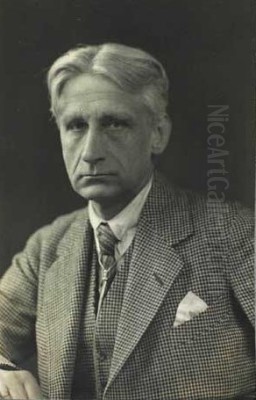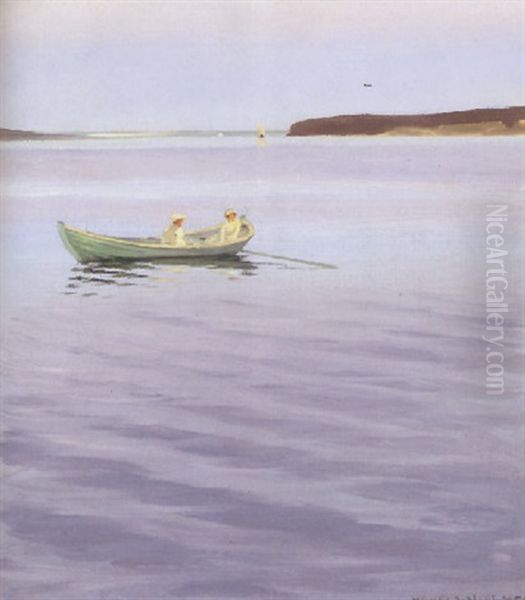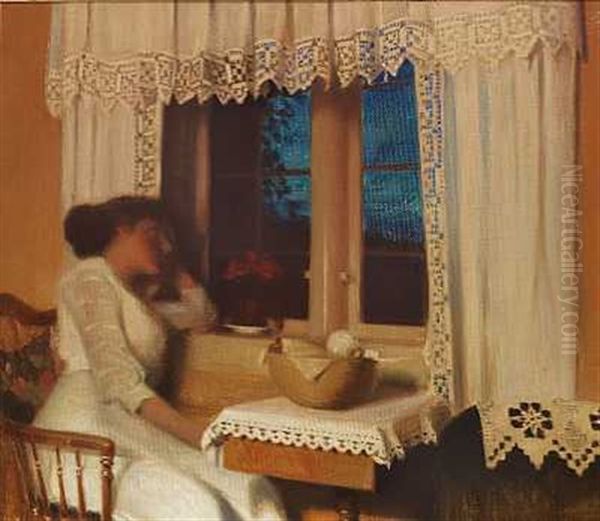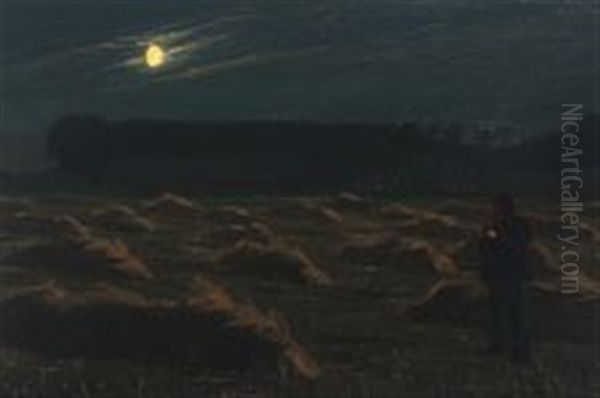
Harald Slott-Møller stands as a significant, albeit sometimes controversial, figure in Danish art history. Active during a period of profound artistic transition in the late nineteenth and early twentieth centuries, he navigated the currents of Naturalism, Symbolism, and the burgeoning Arts and Crafts movement. Born in Copenhagen on August 17, 1864, and passing away in the same city on October 20, 1937, Slott-Møller's life spanned an era of intense cultural debate and artistic innovation in Denmark. He was not only a painter of considerable skill, particularly noted for his portraits and symbolically charged landscapes, but also a respected ceramist, contributing significantly to the applied arts of his time. His journey reflects the broader shifts in European art, moving from objective representation towards more subjective and decorative modes of expression.
Slott-Møller's engagement with the art world was multifaceted. He was an artist seeking personal expression, an educator through his association with influential teachers, a collaborator, particularly with his artist wife, Agnes Slott-Møller, and a key player in establishing alternative exhibition platforms like Den Frie Udstilling (The Free Exhibition). His legacy is complex, marked by periods of acclaim and criticism, yet his contribution to the diverse tapestry of Danish art remains undeniable. This exploration delves into his life, artistic development, key works, professional relationships, and lasting impact.
Early Life and Artistic Formation
Harald Slott-Møller's roots were firmly planted in Copenhagen. His parents were Carl Emil Møller and Anna Maria Møller (née Møller). His formal artistic education began relatively conventionally for the time. In 1882, he enrolled at the technical school known as Ad. Helles' Kunstskole (Art School) to prepare for academic training. The following year, 1883, marked his entry into the Royal Danish Academy of Fine Arts (Det Kongelige Danske Kunstakademi). He completed the preparatory class, a standard step for aspiring artists seeking entry into the Academy's more advanced programs.

However, Slott-Møller did not pursue the full academic course at the Academy in the traditional manner. Instead, after his initial training there, which concluded around 1885, he sought further instruction elsewhere. This decision reflected a growing trend among younger artists who found the Academy's teaching methods rigid and out of step with contemporary artistic developments, particularly the influence of French Naturalism and Impressionism.
A pivotal moment in his artistic development came through his association with Peder Severin Krøyer. From approximately 1883 to 1886, Slott-Møller studied privately under Krøyer, one of the most celebrated Danish painters of the era and a leading figure of the Skagen Painters. Krøyer's own training included time in Paris, and his teaching emphasized keen observation, mastery of light, and vibrant brushwork. Slott-Møller became recognized as one of the most talented pupils in Krøyer's circle, absorbing lessons in technique and composition that would inform his early work.
Emergence and Naturalist Leanings
Slott-Møller made his official debut as an artist in 1886 at the prestigious Charlottenborg Spring Exhibition, the annual juried exhibition associated with the Royal Danish Academy. This marked his entry into the professional art scene in Copenhagen. His early works bore the imprint of his training, particularly the influence of Krøyer and the prevailing Naturalist movement, which focused on depicting everyday life and landscapes with objective accuracy and attention to detail.
He quickly gained attention. In 1888, his large-scale painting Fattigfolk i Fattiglægtes Venteværelse (Poor People in the Poor Doctor's Waiting Room) was exhibited and garnered significant notice. This work, tackling a theme of social realism, demonstrated his ability to handle complex multi-figure compositions and convey a sense of atmosphere and social commentary, aligning with the "Modern Breakthrough" (Det Moderne Gennembrud) literary and artistic movement in Scandinavia that emphasized contemporary social issues.
Another notable work from this period is Sommerdag (Summer Day), also from 1888. This painting, potentially reflecting the lighter side of Naturalism influenced by Impressionistic tendencies towards capturing fleeting moments and the effects of light, showcased his skill in rendering figures in outdoor settings. These early successes established Slott-Møller as a promising young talent within the Danish art world, adept at the techniques and subjects favored by the dominant Naturalist school, alongside contemporaries like the Skagen painters Michael Ancher and Anna Ancher.
Marriage and Artistic Partnership: Agnes Slott-Møller

A crucial development in both Harald Slott-Møller's personal and professional life occurred in 1888 when he married fellow artist Agnes Rambusch (1862-1937). Agnes was a talented painter in her own right, known for her interest in Danish history, folklore, and medieval themes, often executed with a strong sense of line and decorative composition. Their marriage marked the beginning of a lifelong partnership that was both personal and artistic.
Agnes Slott-Møller became a frequent subject in Harald's work. His 1887 portrait, Agnes Rambusch (painted before their marriage), is considered a significant piece from his early career. It demonstrates his technical prowess, particularly in rendering textures like fabric and skin, and capturing the sitter's personality. Some sources note this portrait was considered quite bold or even controversial at the time, perhaps due to its directness or modern sensibility, showcasing his skill honed under Krøyer in depicting details like jewels and lace with remarkable fidelity.
The couple shared artistic interests and ambitions. They often traveled together, including trips to Italy, which influenced their work. More significantly, they became key figures in the movement seeking alternatives to the established academic system. Their shared vision and mutual support were instrumental in their decision to help found Den Frie Udstilling, positioning them as a prominent artist couple within the Copenhagen art scene. Agnes's own artistic career flourished alongside Harald's, though her focus remained more consistently on historical and national romantic subjects.
The Turn Towards Symbolism
While Slott-Møller's early work was grounded in Naturalism, the late 1880s and early 1890s saw a significant shift in his artistic direction, mirroring a broader European trend away from objective reality towards more subjective, evocative, and symbolic modes of expression. This transition marked his engagement with Symbolism, an international movement that sought to express ideas, emotions, and spiritual values through suggestive imagery, often drawing inspiration from mythology, dreams, and the inner world.
His travels, particularly to Italy, likely exposed him to Renaissance and medieval art, which resonated with the Symbolist interest in historical styles and flattened perspectives. He began to incorporate simplified forms, stronger outlines, and more intense, often non-naturalistic colors into his work. The emphasis moved from capturing the fleeting effects of light and atmosphere to creating compositions with a more deliberate, decorative, and emotionally charged quality.

This stylistic evolution is evident in works created around the time of the founding of Den Frie Udstilling in 1891. His painting Dansk Landskab (Danish Landscape), exhibited that year, exemplifies this new direction. While depicting a recognizable Danish scene with fields, storks, and sky, the composition is stylized, emphasizing strong horizontal bands of color and pattern, imbuing the landscape with a symbolic resonance, perhaps representing the essence of the Danish nation or spirit. The influence of Synthetism, associated with artists like Paul Gauguin and the Pont-Aven school in France (whose ideas were disseminated in Denmark partly through artists like J.F. Willumsen), can be discerned in the flattened forms and bold color fields.
Other works often cited as representative of his Symbolist phase include Tre Kvinder (Three Women) and Foråret (Spring, sometimes referred to as Spring Goddess). These paintings moved further away from naturalistic depiction, employing allegorical figures and decorative elements to explore themes of life, nature, and perhaps mythology or psychological states. His interest in medieval art, shared with his wife Agnes, also informed this period, influencing the linearity, richness of detail, and sometimes archaic feel of his compositions.
Den Frie Udstilling: A Platform for Independence
The dissatisfaction with the conservative exhibition policies of the official Charlottenborg Salon, which often rejected more experimental or stylistically innovative works, culminated in the founding of Den Frie Udstilling (The Free Exhibition) in 1891. Harald Slott-Møller, alongside his wife Agnes, was a key figure in its establishment. This new artists' association was explicitly modeled on the Salon des Refusés in Paris, created to provide an independent venue for artists whose work did not conform to academic standards.
Den Frie Udstilling quickly became a crucial platform for the avant-garde and stylistically diverse artists in Denmark. Its founding members represented a range of artistic tendencies, including Symbolism, Synthetism, and individualistic approaches to landscape and figure painting. Besides the Slott-Møllers, prominent founding members included Johan Rohde (the primary initiator), J.F. Willumsen, Vilhelm Hammershøi, the brothers Joakim Skovgaard and Niels Skovgaard, and Theodor Philipsen, among others.
Slott-Møller exhibited regularly at Den Frie in its early years. The inaugural exhibition in 1891 featured several of his works, including the aforementioned Dansk Landskab. This venue allowed him and his contemporaries to showcase their developing Symbolist and decorative styles without the constraints of the Academy jury. The establishment of Den Frie marked a significant moment of artistic independence in Denmark, fostering experimentation and providing a vital alternative to the established art institutions. Slott-Møller's role as a co-founder underscores his commitment to artistic renewal and his position within the progressive circles of Danish art at the turn of the century. The association continues to exist today, a testament to the enduring need for independent artist-run exhibition spaces.
Portraiture: A Defining Genre
Throughout his career, even as his style evolved, portraiture remained a significant aspect of Harald Slott-Møller's oeuvre. His training under Krøyer had equipped him with excellent technical skills for capturing likeness and character, but he adapted these skills to suit his changing artistic vision. His portraits often went beyond mere likeness, incorporating elements that reflected the sitter's status, personality, or his own symbolic or decorative concerns.
He became particularly known for his portraits of prominent figures, especially those connected to South Jutland (Sønderjylland) and South Schleswig – regions of significant national importance and sentiment for Denmark, particularly after the loss of Schleswig-Holstein to Prussia in 1864. These commissions likely held personal or patriotic significance for the artist.
His approach to portraiture often involved careful attention to detail, especially in rendering clothing, accessories, and interiors. He sometimes designed specific, often elaborate or symbolic, backgrounds for his sitters, integrating the figure into a larger decorative scheme. This practice aligns with the Arts and Crafts ideal of unifying art and design. His skill in depicting textures – the sheen of silk, the intricacy of lace, the warmth of skin – remained a hallmark, as noted in commentary on works like the portrait of Agnes Rambusch.
While some portraits maintained a degree of naturalism, others incorporated the flattened perspectives, strong outlines, and rich colors characteristic of his Symbolist phase. The goal was often not just representation, but the creation of a powerful, lasting image imbued with a sense of presence and significance. Examples like De sidste Gæster forlader Marie Kruses Sommerbolig en Juniaften (The Last Guests Leaving Marie Kruse's Summer Home on an Evening in June), though perhaps more of a genre scene, showcase his ability to handle figures within atmospheric settings, capturing nuances of light and mood, skills relevant to his portrait work as well.
Mastery in Ceramics and Applied Arts
Beyond his work as a painter, Harald Slott-Møller made substantial contributions to the field of Danish applied arts, particularly ceramics. This dual focus on fine art and craft was characteristic of the period, influenced by the British Arts and Crafts movement led by figures like William Morris, which advocated for the artistic value of handcrafted objects and the integration of art into everyday life. Denmark had its own strong tradition of decorative arts, and Slott-Møller became a leading figure in this domain around the turn of the century.
He was associated with the Aluminia faience manufactory in Copenhagen, a prominent producer of ceramics. There, he collaborated with another significant figure in Danish ceramic design, Christian Joachim Petersen (often known simply as Christian Joachim). Together, they designed notable pieces, contributing to the factory's artistic output and reputation. Slott-Møller's designs likely reflected his painterly interests, possibly incorporating stylized natural motifs, strong colors, and decorative patterns consistent with his Symbolist leanings and the broader Art Nouveau trends of the time.
His involvement in ceramics placed him alongside other Danish artists who successfully bridged the gap between fine and applied arts, such as the multi-talented Thorvald Bindesbøll, known for his ceramics, graphic design, and architecture. Slott-Møller's work in this field demonstrated his versatility and his commitment to the idea that artistic principles could and should be applied across different media. He was recognized as one of the leading Danish "kunsthaandværkere" (artist-craftsmen) of his generation, contributing to the high international standing of Danish design.
Later Career and Shifting Reputation
As the twentieth century progressed, the artistic landscape continued to evolve rapidly. While Slott-Møller remained active, his position relative to the avant-garde shifted. The Symbolist and National Romantic styles, which had been progressive in the 1890s, gradually became less central as new movements like Fauvism, Cubism, and Expressionism emerged in Europe and began to influence younger Danish artists.
Some sources suggest that Slott-Møller's later work, while technically proficient, sometimes adhered to the styles he had developed earlier, or perhaps took on a more conservative or nationalistic tone, which could lead to criticism from those embracing modernism. Public and critical reception of his work may have fluctuated. Despite this, he continued to produce significant paintings and portraits. His work Længsel (Longing), dated 1913 and now housed in the ARoS Aarhus Art Museum, is cited as an important later piece. Another late work mentioned is Sejlads i Søstrup Slots park (Boating in the Grounds of Sostrup Castle) from 1917, indicating his continued engagement with landscape and figurative themes.
He continued to exhibit, including at Charlottenborg in 1917 and potentially other venues like the Foråret (Spring) exhibition mentioned in relation to an 1896 showing of Den himmelens og den jordens kærlighed (The Love of Heaven and Earth). However, like many artists of his generation who had been pioneers in their youth, he faced the challenge of maintaining relevance in a rapidly changing art world. His strong personality and perhaps fixed artistic views might have also contributed to occasional friction or controversy within the art community.
Teacher-Student Relationships
The provided information indicates that Harald Slott-Møller received significant training from Peder Severin Krøyer, highlighting a clear teacher-student relationship where Slott-Møller was the pupil. Krøyer's influence, particularly on his early naturalistic technique and handling of light and texture, is well-documented. Slott-Møller was considered one of Krøyer's most distinguished students during his time at the Kunstnernes Frie Studieskoler (Artists' Free Study Schools), where Krøyer taught.
However, regarding Slott-Møller himself acting as a formal teacher, the available sources consulted for the initial query explicitly state that there is no known record or list of students directly taught by him. While artists often influence younger generations through their work and presence in the art community, there is no specific evidence presented that he maintained a formal studio school or mentored specific individuals in the same way Krøyer did. His influence would have been primarily through his exhibited work, his role in Den Frie Udstilling, and his general participation in the artistic discourse of his time.
Collaborations and Artistic Circles
Harald Slott-Møller's career was marked by significant interactions with other artists, both collaborative and potentially competitive. His most important collaboration was undoubtedly with his wife, Agnes Slott-Møller. They shared artistic ideals, co-founded Den Frie Udstilling, traveled together, and sometimes exhibited works that complemented each other thematically or stylistically. Their partnership was a central feature of their lives and careers.
His work in ceramics involved a direct professional collaboration with Christian Joachim at the Aluminia factory. This partnership was focused on applied arts design, bringing together their respective skills to create notable ceramic pieces.
The founding of Den Frie Udstilling placed him in direct collaboration with a diverse group of leading contemporary artists, including J.F. Willumsen, Vilhelm Hammershøi, Johan Rohde, and the Skovgaard brothers. While united in their desire for an independent exhibition venue, these artists had distinct styles and temperaments, suggesting a dynamic environment of shared purpose mixed with individual artistic pursuits.
Naturally, the art world also involved competition. Slott-Møller operated within the same sphere as his former teacher, P.S. Krøyer, who remained a dominant figure. While Krøyer represented the established success of the Skagen school and Naturalism, Slott-Møller moved towards Symbolism, creating a point of differentiation but also potential comparison. He exhibited alongside and competed for attention and patronage with other Symbolist-inclined artists like Ejnar Nielsen and Hammershøi (though Hammershøi's quiet introspection differed greatly from Slott-Møller's often bolder style), as well as the broader field of Danish artists active at the time. His works appeared in auctions alongside other Nordic artists, placing him within the competitive art market context.
Legacy and Conclusion
Harald Slott-Møller occupies a unique and complex place in Danish art history. He was an artist of considerable technical skill, capable of producing both detailed naturalistic works and powerful symbolic compositions. His career trajectory reflects the major artistic shifts occurring at the turn of the twentieth century, as he moved from the Realism championed by the generation of the Modern Breakthrough and the Skagen Painters towards the subjective and decorative concerns of Symbolism.
His role as a co-founder of Den Frie Udstilling was pivotal, contributing significantly to the liberalization of the Danish art scene and providing a vital platform for non-academic art. This act cemented his position among the progressive forces of his time. Furthermore, his successful engagement with the applied arts, particularly ceramics, highlights his versatility and his connection to the broader Arts and Crafts ethos that sought to elevate craftsmanship and integrate art into life. He stands alongside figures like Thorvald Bindesbøll in bridging the perceived gap between fine art and decorative design.
While his later career may have seen his style fall somewhat out of step with the emerging modernist avant-garde, and his work occasionally drew criticism, his key paintings remain important examples of Danish Symbolism. Works like Dansk Landskab, the portrait of his wife Agnes, Fattigfolk i Fattiglægtes Venteværelse, and Længsel are held in major Danish museum collections and attest to his artistic significance. He remains a testament to an era of rich artistic exploration in Denmark, an artist who navigated the transition between centuries and styles, leaving behind a diverse body of work in both painting and ceramics. His partnership with Agnes Slott-Møller also stands as a notable example of a dynamic artist couple contributing jointly to their nation's cultural life.